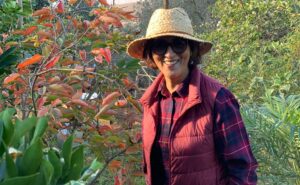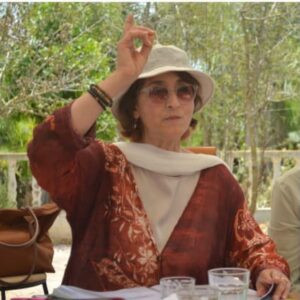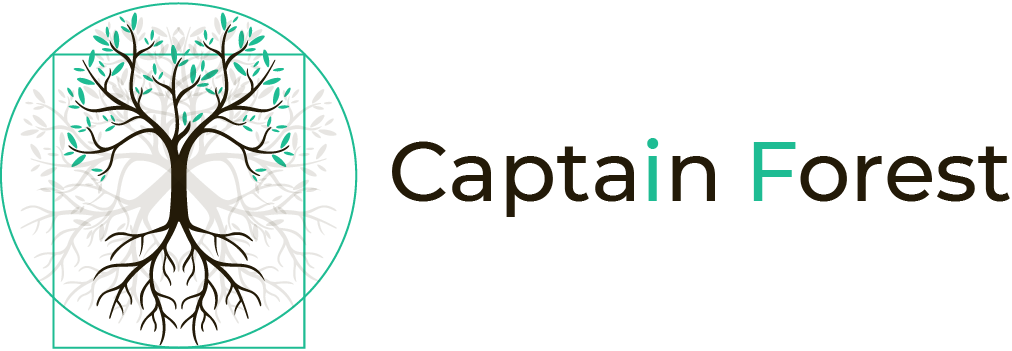This article is also available in French: click here.
Why is the Human Dimension Essential to Permaculture Projects?
Lamiaa Biaz, the founder of Captain Forest, met Zineb Benrhamoune Idrissi in 2020 to visit her permaculture farm in Rabat, Morocco. What struck her most in Zineb’s project was the importance of the human dimension. Permaculture is not about gardening or using sustainable methods but about building harmony between humans, society, and nature.
In this exclusive interview with Captain Forest, Zineb explains why the human dimension is essential to any permaculture project.
Q: Can you tell us what got you into permaculture?
 At first, I never really looked into permaculture; I didn’t even know the term. I was disappointed with how agriculture was practiced and ecosystems were managed. These disappointments triggered something within me.
At first, I never really looked into permaculture; I didn’t even know the term. I was disappointed with how agriculture was practiced and ecosystems were managed. These disappointments triggered something within me.
When I visited an agroecological project in the region of Montpellier and read Pierre Rabhi’s first book, “From the Sahara to the Cevennes”, it reconciled me with the agricultural world and reinforced my convictions.
This is how I started to look for a piece of land. I was animated by the will to re-establish a harmonious connection between the human and plant, and animal worlds.
Q: What was it, in particular, that disappointed you in modern agricultural practices?
I occasionally participated in impact studies as a botany and forest ecology specialist. We produced many documents, but I noticed that little was put into practice in the field.
I also saw that in the agricultural world, there was, on the one hand, traditional agriculture, which was arduous work with minimal yield, and on the other hand, conventional agriculture (modern agriculture), which maintained a form of arrogance where science and technology considered themselves above the living: use of pesticides, war on “weeds”, monoculture, mistreatment of animals, etc.
It was as if capitalism was also applied to Earth and the living world.
Q: How did you learn about permaculture?
I had no technical expertise, only a passion for nature and a deep connection with people. My experience was limited to planting by hand and watering.
My background in botany and forest ecology helped me interpret landscapes, and my involvement in community activities gave me a grounding in field anthropology.
My keen observation skills allowed me to work by mimicking natural processes.
After a few years, I was invited to a permaculture training, where I realized that I had been practicing permaculture all along without even knowing it.
Q: Tell us about how you started your project and how you trained along the way?
I had bought a sloping piece of land in a rural area. Usually, people prefer to farm on a flat piece of land. It was a real challenge, but I liked the slope because it allowed me to collect as much rainwater as possible.
From the beginning, the issues of trees and living soil were essential to me; my first action was to plant trees to recreate an ecosystem.
In 1998, there wasn’t any information on social media (YouTube, for example), nor were there developed studies and literature on permaculture. I learned gradually through hands-on experiences and the invaluable magic of meaningful encounters.
In particular, I had the chance to meet Pierre Rahbi in person (may he rest in peace), thanks to the President of the association “Terre et Humanisme” Morocco, Fattouma Djerrari, who had suggested that I participate in the training of Moroccan facilitators in agroecology.
During these pieces of training with the “Terre et Humanisme” teams, I reinforced my practical knowledge of market gardening techniques and how to run a vegetable garden, even though I was myself a professor teaching landscape reading, ecology, the place of the tree, and the importance of living soil.
At the same time, I received as a gift Fukuoka‘s amazing book, “The One-Straw Revolution“, which relates the philosophy and principles of permaculture.
Accumulating knowledge is essential, but what counts in permaculture is experimenting.
Q: Why is experience more important than knowledge accumulation in permaculture?
I like Einstein’s sentence, “Knowledge is acquired through experience. Everything else is just information”.
I often encounter people who can recite permaculture videos word for word without ever having set foot in the field. While reading books and watching videos can be a good starting point, true learning comes from hands-on experience, experimenting in the field day by day.
Q: Can you tell us about the social dimension of your project?
The human dimension is vital in any permaculture project. My journey wasn’t easy; it required patience and sometimes a tough resolve for the process to evolve and the project to succeed.
The first step was to find teammates. Very quickly, I recruited a young shepherd from the neighborhood, Mustafa Souaada, who later became my spiritual son, accompanying the project from the beginning until today.
This young man knew traditional agriculture techniques but needed to learn sustainable methods. Therefore, I trained him to use the permaculture approach while learning with him through practicing in the field.
 In reality, creating a bond with the neighborhood took work. Everyone watched this “educated” woman, neither a farmer nor a city dweller, who practiced neither traditional nor conventional agriculture. Therefore, the second step was to “impose” myself in the neighborhood and show them results to become a source of inspiration.
In reality, creating a bond with the neighborhood took work. Everyone watched this “educated” woman, neither a farmer nor a city dweller, who practiced neither traditional nor conventional agriculture. Therefore, the second step was to “impose” myself in the neighborhood and show them results to become a source of inspiration.
Over time, I set up shared governance of a community project. This was a real challenge and a long process to implement because it was first necessary to get the representatives of vulnerable rural families to join the project individually.
They had to understand that the successes and failures of the project were shared. If the work goes well and the crops are bountiful, everyone benefits; everyone is responsible if there are losses.
Conveying the social solidarity aspect of the project was crucial. Once the rural families grasped this approach, our relationship and the project itself transformed. They truly took ownership of the initiative, marking the third step of my permaculture project.
Moreover, having been an activist in a women’s association, I have always insisted that men and women should receive the same salary. So, I have always ensured that wages are equal between men and women.
Q: How do you define permaculture?
Beyond being a part of agroecology, permaculture is an approach to life. The human dimension is fundamental: caring for the human and sharing the surplus.
The second important thing in permaculture is the observation of nature to imitate it later. The notions of observation and experimentation in the field are essential. It is a question of adapting as much as possible to the eco-biology phenomena.
Finally, permaculture is defined primarily as the culture of sustainability. In this culture, there is an evolution because everything adapts permanently in space and time, and everything is a continuity from one state to another.
After several years, the system becomes almost self-sufficient. It can produce its own irrigation and natural fertilizers and manage all difficulties and diseases. It will only need some maintenance from the farmer.
Q: What advice would you give to people who are just starting?
Permaculture can be practiced everywhere, in the countryside and the city, because it is a philosophy of life where humans live in harmony with nature.
Before starting a project in permaculture, I advise being formed obligatorily in design to consider the data of the environment, the available resources, and the people implied in the project. Also, each project must have an intention, depending on the manager’s capacities.
Q: How would you like to conclude this interview?
Usually, when people see a successful project, they don’t realize that it took many failures to get there. I have fallen and had to get up more than once to continue my journey.
It is also important to have a holistic approach and look for meaning in what we do and in our projects.
Moreover, we must take care of the Earth and humans to restore humanity.
Finally, we humans need to share this Earth with the living world, and we must do so with love and peace to receive the blessing and the baraka of the Divine.
What about you? Do you think the human dimension is essential to permaculture projects? Please comment and react.




